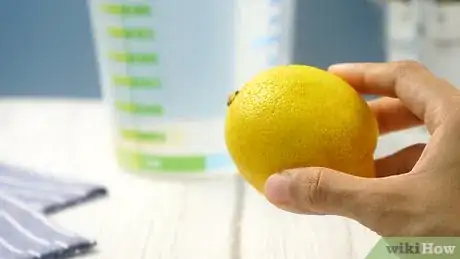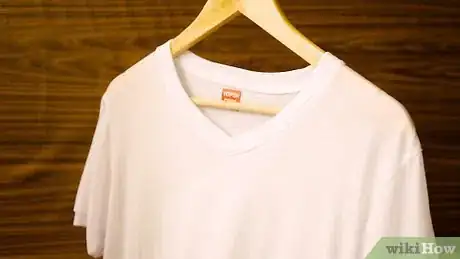This article was co-authored by Susan Stocker. Susan Stocker runs and owns Susan’s Green Cleaning, the #1 Green Cleaning Company in Seattle. She is well known in the region for outstanding customer service protocols — winning the 2017 Better Business Torch Award for Ethics & Integrity —and her energetic support of green cleaning practices.
This article has been viewed 70,003 times.
Hand washing your white clothes can help them last longer, especially if they’re made out of delicate fabrics. It takes a little more work than using the washing machine, but it’s so worth it. Below we’ll walk you through the whole process step-by-step, from pre-treating stains to hand washing your whites to drying them when you’re finished.
Steps
Treating Stains
-
1Spot treat stains so they don't set into your clothes. Before washing your white clothes, take a moment to thoroughly look them over and check for any stains or discolorations. Treat these spots before you move on to hand washing, otherwise, the stain could become a permanent part of your garment.[1]
- If you're on the go, carry a stain-remover pen with you to treat small spots that show up over the course of the day.
- If you can, treat a stain as soon as possible. Dab at the stain rather than rubbing, and use cold water to try and rinse it away. This will make it less likely that the stain will become permanent.
-
2Bathe the clothes in bleach to remove stains and brighten your clothes. When working with bleach, wear gloves to keep it off of your skin, work in a well-ventilated area, and keep it out of your eyes. Measure 1⁄4 cup (59 mL) of chlorine or laundry-specific bleach into a bucket, along with 1 gallon (3.8 L) of water. Put your clothes into the bucket and let them soak for 15 to 30 minutes. Once they're done soaking, carefully dump out the bleach, gently wring out your clothes, and wash them as usual.[2]
- If you've never bleached this particular item before, test the bleach on an inconspicuous location first to make sure it doesn't ruin the fabric (the inside of a cuff or collar is a great spot to try).
- Set a timer when working with bleach—leaving the clothes in the bleach mixture for too long could ruin the fabric.
Advertisement -
3Use hydrogen peroxide for hard-to-remove stains, like wine or grass. Soak a cotton ball (or several) in hydrogen peroxide. Dab the stain until it is completely saturated. Let the hydrogen peroxide do its work for about 30 minutes before rubbing the stain with a wet towel. Rinse the stained area, repeat the stain-removal process if you need to, and then move on to washing it.[3]
- When rubbing the stained area, use very gentle pressure. Too much rubbing can wear out the fabric and could even fray it if it's done too hard.
-
4Soak the clothing in lemon juice for a safe alternative to bleach. For white clothes that are looking a little dingy, lemon juice can really brighten them up. Fill a clean bucket with 1 gallon (3.8 L) of hot water and 1⁄2 cup (120 mL) of lemon juice. Submerge the clothing in the bucket and let it soak for at least 1 hour. Drain the water, gently squeeze the excess out, and then move on to the washing.[4]
- You have to use real lemons for this. The pre-bottled stuff won’t work as well.
- This is especially good at getting armpit stains out.[5]
Warning: Don't use this method on silk clothes. It'll work best on cotton and polyester garments.
-
5Treat armpit stains with a paste made of baking soda and water. Make a paste out of 4 tablespoons (60 grams) of baking soda and 1⁄4 cup (59 mL) of warm water. Stir the two ingredients together until they're completely combined. Wet the stained area on your shirt, and then apply a thick layer of paste to it. Gently rub the paste into the fabric, and then let it sit for 30 to 60 minutes. Rinse out the paste and then wash the garment.[6]
- Treat armpit stains every time you wash the garment to keep them from building up and becoming permanent.
Did You Know? Armpit stains are often caused by your sweat reacting with the aluminum in your deodorant. To curb this issue, look for an antiperspirant that is aluminum-free.
Washing the Clothes
-
1Check the label for special instructions before you begin. “Dry-clean only” means you shouldn't wash it yourself at home, even if you do it by hand. Check out the water temperature, detergent expectations, and drying instructions so that you're fully prepared to wash your clothes the right way.[7]
- Pay special attention to directions regarding bleach. If an item says “do not bleach,” you'll be better off heeding that advice. Bleach can be great and get items bright and clean, but it also can be pretty abrasive and can wear down fibers quickly, making your clothes threadbare before too long.
-
2Fill a clean tub or sink with water based on the care label instructions. Some clothing items need to be washed in cold water, while others need warm or hot water. Do whatever the label says to care for your clothes as best as possible.[8]
- Make sure your sink or tub is clean before you use it. If needed, give it a quick scrub with warm water and dish detergent. Rinse it out thoroughly so there is no soap residue.
- If the temperature wasn't specified on the label, use cool to lukewarm water.
-
3Add 1 teaspoon (4.9 mL) of mild detergent to the water. 1 teaspoon (4.9 mL) of detergent will be enough for 2 to 3 items of clothing, so adjust the amount if you're washing more than that at once. Add the detergent while the water is filling up so that it gets sudsy and is ready for the clothing.[9]
- You can also use a small amount of chlorine bleach with the laundry detergent for whiter and brighter clothes. 1 tablespoon (15 mL) of chlorine bleach is enough for 1 gallon (3.8 L) of water. Wear gloves if you use bleach and work in a well-ventilated area.[10]
Warning: Never mix bleach with ammonia, as the fumes can be toxic.
-
4Submerge and swish the clothing through the water to get it sudsy. Once the tub or bucket is full, go ahead and put the clothing into it and start moving it around. Swish it back and forth through the water so the soap has a chance to move through the fabric. Do this for 3 to 4 minutes to ensure the entire piece is clean.
- Never wash your white clothes with dark clothes.
-
5Drain the water from the tub and refill it with cool water. After you're done washing the clothes, pull the plug and let the sudsy water drain away. Push the wet clothing to the side and refill the tub rather than just running water from the faucet directly through the fabric—this could stretch the material out.
- You don't need to fill the tub back up all the way. Just fill it enough so that the clothing is completely submerged and you have some room to swish it about some more.
-
6Continue swishing the clothing until all the soap suds are gone. Clear away the suds by moving the clothing about in the cool water. If you need to, drain and refill the tub again until you're sure it has all come clean.[11]
- Having used the appropriate amount of detergent really pays off at this stage. If you didn't measure and used too much, you may be standing at the sink for a while rinsing out the excess suds.
- Smell the clothes if you're not sure all the soap is gone. A strong scent indicates there is still detergent that needs to be rinsed away.}}
Drying Hand-Washed Clothes
-
1Squeeze the excess water out of the clothes very gently. Don't wring the clothes or twist them, as that could stretch out the fibers and misshape the clothing. Instead, gather the clothing in your hands and simply press the fabric together, moving it around and reshaping it to access all areas. Continue doing this until the garment is no longer dripping wet.[12]
- If you do wring the fabric, use the amount of force you'd use to open a bottle of water.
-
2Put the clothing on a dry, clean, lint-free white towel. Lay out a white towel on a waterproof surface, then spread out your while clothing on the towel. Go ahead and unfold or un-bunch the clothing so it lays as flat as possible.[13]
- Towels that have been washed and dried a few times should be primarily lint-free.
-
3Roll up the towel and press down on the clothing to absorb the water. Either roll the towel up so that the garment is spiraled around the inside of the towel, or fold the towel up into equally-sized sections. Then firmly press down on the towel with your hands. Continue pressing down all over the towel so that you hit every area and soak up as much water as possible.[14]
- Use another towel if the first one gets too wet and can't soak up any more water.
-
4Dry the clothing in the sun for a natural bleaching effect. Use a clothesline and clothespins if your garment isn't too delicate to be hung. If it looks like it's going to rain or if it's wintertime, you'll be better off using a drying rack indoors.
- If you do line dry your clothes outside, don't forget to bring them in before you go to bed. Early morning dew will make them wet again and could cause them to wrinkle.
Alternative: If the item can't be hung to dry and you don't have a drying rack, lay it out on top of a clean white towel and reshape it. Flip it over occasionally so it dries evenly.
-
5Iron the item if it is wrinkly and put it away once it has dried. Revisit the care label to see if the item can be ironed. If so, and if it needs it, take a few moments to iron it before putting it away so that the wrinkles don't set into the fabric more deeply. Hang up your clothes or put them away in drawers to keep them in good shape for the next time you want to wear them.[15]
- Putting away clothes as soon as they have dried will help keep them from getting wrinkled in the first place.
Expert Q&A
Did you know you can get expert answers for this article?
Unlock expert answers by supporting wikiHow
-
QuestionDo white clothes have to be washed separately?
 Susan StockerSusan Stocker runs and owns Susan’s Green Cleaning, the #1 Green Cleaning Company in Seattle. She is well known in the region for outstanding customer service protocols — winning the 2017 Better Business Torch Award for Ethics & Integrity —and her energetic support of green cleaning practices.
Susan StockerSusan Stocker runs and owns Susan’s Green Cleaning, the #1 Green Cleaning Company in Seattle. She is well known in the region for outstanding customer service protocols — winning the 2017 Better Business Torch Award for Ethics & Integrity —and her energetic support of green cleaning practices.
Cleaning Professional
Things You'll Need
Treating Stains
- Hydrogen peroxide
- Cotton balls
- Towel
- Chlorine or laundry-specific bleach
- Lemon juice
- Bucket
- Baking soda
- Small bowl
- Spoon
Washing the Clothes
- Tub or sink
- Mild detergent
- Chlorine bleach (optional)
Drying Hand-Washed Clothes
- Lint-free white towel(s)
- Clothesline or drying rack
- Iron and ironing board (optional)
References
- ↑ https://www.cleanipedia.com/gb/laundry/wash-white-clothes.html
- ↑ https://www.goodhousekeeping.com/home/cleaning/a24670/3-secrets-to-keeping-your-whites-white/#
- ↑ https://www.cleanipedia.com/gb/laundry/wash-white-clothes.html
- ↑ Susan Stocker. Cleaning Professional. Expert Interview. 8 November 2019.
- ↑ Susan Stocker. Cleaning Professional. Expert Interview. 8 November 2019.
- ↑ Susan Stocker. Cleaning Professional. Expert Interview. 8 November 2019.
- ↑ https://www.bhg.com/homekeeping/laundry-linens/clothes/how-to-wash-clothes-by-hand/
- ↑ https://www.bhg.com/homekeeping/laundry-linens/clothes/how-to-wash-clothes-by-hand/
- ↑ https://www.bhg.com/homekeeping/laundry-linens/clothes/how-to-wash-clothes-by-hand/
- ↑ https://www.whowhatwear.com/how-to-bleach-clothes/slide2
- ↑ https://www.bhg.com/homekeeping/laundry-linens/clothes/how-to-wash-clothes-by-hand/
- ↑ https://www.bhg.com/homekeeping/laundry-linens/clothes/how-to-wash-clothes-by-hand/
- ↑ https://www.bhg.com/homekeeping/laundry-linens/clothes/how-to-wash-clothes-by-hand/
- ↑ https://www.bhg.com/homekeeping/laundry-linens/clothes/how-to-wash-clothes-by-hand/
- ↑ https://www.bhg.com/homekeeping/laundry-linens/clothes/how-to-wash-clothes-by-hand/
About This Article
Before washing white clothes by hand, check the label for any special instructions. For example, the label might specify what temperature of water to use or which kinds of detergent are safe for your clothes. Next, fill a clean tub or sink with water. The label on the item should say whether to use cold, warm, or hot water. If you’re not sure, lukewarm water is a safe bet. Add about 1 teaspoon of mild laundry detergent to the water and mix it in. To make your clothes extra bright, you can also add a tablespoon of bleach per gallon of water, as long as the items are safe to bleach. Submerge each item in the water and swish it around with your hands to get it sudsy. Keep doing this for 3 to 4 minutes, then remove the items and set them aside on a clean surface. Refill your tub or sink with clean water, put the clothes back in, and swish them around again to rinse them. You may need to drain and refill the tub a few times to thoroughly rinse out all the detergent. When you’re done, gently squeeze the excess water out of the clothes. Lay each item out flat on a clean, dry white towel, then roll up the towel with the garment inside to soak up as much water as you can. Hang the clothes up someplace warm and dry, like on a clothesline in the sun or on an indoor drying rack if it’s cold or wet outside. Scroll on for more expert tips, like how to spot-treat stains on white clothes before cleaning them.



























































